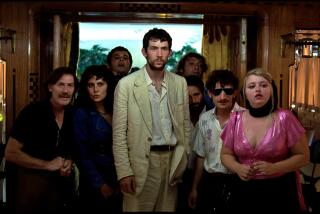Rohmer’s ‘Lady’ Is in Step With Revolutionary Times
- Share via
How did old master Eric Rohmer come to make the technologically inventive “The Lady and the Duke”? As the 82-year-old writer-director explained to an interviewer, “I like to get out from time to time.”
Given that Rohmer is one of the grand old men of the French cinema, who’s been making films like “My Night at Maud’s,” “Claire’s Knee” and the more recent “Autumn’s Tale” for more than half a century, you might think that getting out would involve nothing more taxing than a trip to the local cafe.
But Rohmer, with his gift for surprising audiences, had something more innovative and even ground-breaking in mind.
Entranced by “Journal of My Life During the French Revolution,” the little-known memoirs of a Scottish aristocrat named Grace Elliott, Rohmer decided to make a historical film set in those troubled times. He wanted to make it in a way that only brand-new digital technology would make possible.
Frustrated that period films set in Paris never look like Paris because they’re filmed in “Le Mans, Uzes or other towns with well-preserved historic neighborhoods,” Rohmer commissioned artist Jean-Baptiste Marot to paint 37 backgrounds representing the Paris of the time. These were digitally inserted into the film and combined with the actors’ work, also shot on digital beta, to make a finished image that was then transferred to 35 millimeter.
This fascinating experiment plays as more of a poetic than a strict reality, creating an intriguing species of artifice that gives “The Lady and the Duke” something of a theatrical air. Just as interesting, if not more so, is how Rohmer integrates his very contemporary concerns into a period drama, how he creates characters who manage to be true to our times as well as their own.
While a certain familiarity with the French Revolution is helpful, even viewers who don’t know from Robespierre will appreciate the qualities Rohmer brings to all his films. For the lady and the duke of the title have one of those intricate, talky relationships all Rohmer couples have, one characterized by intellectual sparring, impossible situations and clashes of wills.
The lady, Grace Elliot, gracefully played by Lucy Russell (of Christopher Nolan’s debut film, “Following”), was once the mistress of the prince of Wales. She left him and moved to France for the duke of Orleans, a cousin of Louis XVI. By the time the film opens in 1790, a year after the fall of the Bastille, the affair is over but Grace has remained in France and she and the duke have stayed close friends.
But just because they’re friends doesn’t mean they can’t (and don’t) have powerful political arguments. Grace is an unapologetic royalist, a close friend of Marie Antoinette, who believes strongly in the king. By contrast, the duke, the king’s cousin, says he feels much “more French than Bourbon” (and in fact was eventually to change his family name to Egalite). Organized around five specific moments in the revolution, Rohmer’s fluid drama reveals personalities as it shows how lady and duke responded to the momentous times they were living through.
The duke, convincingly played by Jean-Claude Dreyfus (“Delicatessen,” “The City of Lost Children”), comes across as both oily and earnest, an aristocrat trying hard to be a man of the people. A citizen with more passion than intellect, he is likely, as Grace understands, to be led astray and become the prisoner rather than the leader of his more extreme followers.
As for Grace, the dangers of the revolution enable her to come into her own. Always a decisive woman used to doing what she wants to do when she wants to do it, Grace discovers untapped pools of fortitude and resilience to call upon as she needs them.
This is especially the case when she finds herself, in a typically impossible Rohmer predicament--albeit one with potential consequences more serious than usual for his films--risking her life to help a man she despises escape from the clutches of revolutionary justice. Grace is so intrepid you instinctively feel this is the section that made the filmmaker cast his lot with her character.
Although “The Lady and the Duke” has some large-scale crowd sequences (D.W. Griffith’s “Orphans of the Storm” was one of the films Rohmer viewed before the start of production, and it shows), it’s at its best in its most intimate moments, in depicting how complicated the reality of these events was for those forced to live through them. “The revolution will be of great use to our children and grandchildren,” the duke says, speaking for the film, “though it is terrible to witness.”
*
MPAA rating: PG-13 for some violent images. Times guidelines: a scene of a severed head paraded on a pike.
‘The Lady and the Duke’
Lucy Russell...Grace Elliott
Jean-Claude Dreyfus...Le Duc d’Orleans
Francois Marthouret...Dumouriez
Leonard Cobiant...Champcenetz
Caroline Morin...Nanon
A Sony Pictures Classics release. Writer-director Eric Rohmer. Producer Francoise Etchegaray. Executive producers Francois Ivernel, Romain Le Grand, Leonard Glowinski. Cinematographer Diane Baratier. Editor Mary Stephen. Wardrobe designer Pierre-Jean Larroque. Paintings Jean-Baptiste Marot. Art director Antoine Fontaine. Running time: 2 hours, 9 minutes.
In limited release.
More to Read
Only good movies
Get the Indie Focus newsletter, Mark Olsen's weekly guide to the world of cinema.
You may occasionally receive promotional content from the Los Angeles Times.










